Kentucky Pest News Newsletter
HIGHLIGHTS IN THIS ISSUE
Number 890 __________ Jul 10, 2000
ANNOUNCEMENTS
TOBACCO
CORN
SOYBEANS
ALFALFA
VEGETABLES
LAWN AND TURF
SHADE TREES AND ORNAMENTALS
DIAGNOSTIC LAB HIGHLIGHTS
IPM TRAP COUNTS
TOBACCO
CURRENT BLUE MOLD STATUS
By William Nesmith
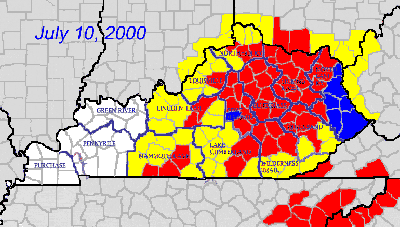 Blue Mold Warning for the following Kentucky Extension Areas: Bluegrass, Ft. Harrod, Licking River, and Northeast Kentucky. A warning means the disease is active and expected conditions should favor continued and increasing activity in the warning area.
Blue Mold Warning for the following Kentucky Extension Areas: Bluegrass, Ft. Harrod, Licking River, and Northeast Kentucky. A warning means the disease is active and expected conditions should favor continued and increasing activity in the warning area.
Blue Mold Watch for the following Kentucky Extension Areas: Lake Cumberland, Lincoln Trail, Mammoth Cave, Louisville, Northern Kentucky, Quicksand, and Wilderness Trail. A watch also has been issued for Southern Ohio, Southeastern Indiana, and western West Virginia.. A watch means that conditions are favorable for the disease to develop and a source of viable spores is believed to be impacting the area under the watch.
Blue mold has become established over much of eastern and northern Kentucky, and extending into southern Ohio.
The activity is mainly at low levels, but some strong activity is also present. Foliar lesions and blighting range
from small fleck-like spots to large lesions the size of a quarter or larger. Some fields have damage with as much
as 20-40% leaf surface spotted/blighted. Systemic infections of the leaf veins and stems have also occurred. The
pathogen has been spread via airborne spores and transplant borne means, some spread over a month ago, and
both means continue to operate currently. I suspect blue mold can be found in about all counties east of Interstate
Highway 65, based on survey data and the few samples submitted to the lab.
The disease is now positioned such that a damaging epidemics of foliar blue mold could develop immediately in
crops with closed or closing canopies. Rapid growth has made plants very susceptible to infections and to being
seriously damaged when infections occur. The cool weather recently experienced should result in large lesions,
heavy sporulation, and systemic development. Temperatures are expected to be higher over the next few days,
but not high enough to check the disease in the eastern and northern regions of Kentucky.
Blue mold is present in fields, traditional plant beds, float beds, and greenhouses, and it is moving in locally-grown
transplants. The most active and damaging cases are associated with sites of fast-growing tobacco in river/creek
bottoms or sinks where cooler and wetter conditions occur at night. The strong association with shade from the
west side of the fields/site observed last week is disappearing, probably because of the cooler temperatures and
more closed canopy. A few cases of serious damage to ridge fields is now being reported. Also, a few very
damaging cases of systemic blue mold have involved the recent setting of infected transplants. The affected
crops are just sitting there while healthy crops are growing rapidly.
In west central Kentucky, several cases involved very low levels of systemic blue mold in crops set in early to mid May.
Based on the symptoms currently present, infections occurred before transplanting or soon afterwards.
Since some of these fields of systemic blue mold involved tobacco now approaching the topping stage, infections
probably occurred 45-60 days ago. Look for plants that are lighter in color to yellow, stunted, or breaking (with
the breaks near but usually above the soil line). The systemic infection cannot be seen until the lower stem is
cut at a leaf position. Such plants may also have soreshin or other diseases moving into the stem and roots,
and several other diseases can cause similar effects. The evidence of old infections supports the hypothesis
that blue mold became established in west central Kentucky in early May, probably as we had advised in our
reports of early May and later. The cooler temperatures and recent rains in south central Kentucky may support
a significant increase in new blue mold activity, but resulting from new cycles of the disease developing from this
old activity. These outbreaks probably also contributed inoculum to central and north-central Kentucky.
****
Status reports by Extension Area or state/region are as follows.
PURCHASE AREA of far western Kentucky: Aware of no reason or evidence to suspect blue mold.
PENNYRILE AREA of western Kentucky: Aware of no reason or evidence to suspect blue mold.
GREEN RIVER AREA of northwestern Kentucky: Aware of no reason or evidence to suspect blue mold.
MAMMOTH CAVE AREA of southwestern/south?central Kentucky: This area is under a Blue Mold Watch. Blue
mold has been confirmed in the counties of: Allen, Barren, and Simpson. The disease has probably been active
at very low levels in this area since early to mid May.
LAKE CUMBERLAND AREA of southern Kentucky: A Blue Mold Watch has been issued with confirmed activity in
Pulaski and Wayne counties.
LINCOLN TRAIL AREA of central and west?central Kentucky: The eastern portion of this area is under a Blue Mold
Watch. Blue mold has been confirmed in the counties of Larue, Nelson, and Washington counties, mainly in river
bottoms.
LOUISVILLE AREA: Blue Mold Watch was posted because the disease is present on the southern approaches and
east of this area, plus low levels of new activity have been confirmed in Shelby County. Winds associated with low
pressure systems last week probably introduced viable spores into the area from areas to the south and east.
NORTHERN KENTUCKY AREA: A Blue Mold Watch was posted last week and the disease was recently confirmed in the
counties of Grant, and Pendleton, but it is probably present in others. Lush tobacco in creek or river bottoms is
much more likely to have blue mold than ridge?land sites.
FORT HARROD AREA of central Kentucky: It is under Blue Mold Warning with confirmed activity in the following
counties: Anderson, Franklin, Garrard, Jessamine, Lincoln, Mercer and Woodford. The disease is active at very
low levels in most communities, with isolated cases of light to moderate activity in shady creek or river bottoms.
Some very strong cases have been found in old plant beds.
BLUEGRASS AREA of central Kentucky: This area is under a Blue Mold Warning with confirmed cases in all
counties, including: Bourbon, Clark, Estill, Fayette, Harrison, Madison, Nicholas, Powell and Scott. The activity
level is mostly low, but some cases of strong and damaging activity are occurring. The potential for damaging
activity is high due to an abundance of vigorous tobacco situated in foggy pockets of sinks, creek, and river bottoms.
LICKING RIVER AREA of north central Kentucky: This area is under a Blue Mold Warning because prevailing winds
should continue to send spores from the Bluegrass, Quicksand, and Wilderness Trail areas into this region,
plus several sites of strong activity are present within. The disease has been confirmed in the following counties:
Bath, Bracken, Fleming, Lewis, Mason, Menifee, Montgomery, Morgan, Robertson and Rowan. Disease potential
is highly variable, but lush crops in low areas are highly vulnerable. Infected transplants are moving about this area
and into others. This region's blue mold is also a threat to southern Ohio and western West Virginia.
NORTHEAST KENTUCKY AREA: This areas is under a Blue Mold Warning, because blue mold is present and
prevailing winds will send blue mold spores directly into this area. Some areas have received significant and
frequent rains. The disease has been confirmed in the counties of: Carter, Elliott, Greenup, and Magoffin, All
reported activity is new, but it is increasing rapidly in cool, wet sites. The region could sustain serious damage
quickly, because all other activity in the state and region are sending spores into this area, plus, cooler
temperatures prevail favoring systemic blue mold, and the crop is young and highly susceptible to systemic
infections.
QUICKSAND AREA of southeastern Kentucky: This area is under a Blue Mold Watch, but local agents may be
putting individual counties under warnings. There is probably a lot more blue mold in the area than has been
reported. The disease has been confirmed in most counties, including: Breathitt, Lee, Owsley, Perry and Wolfe.
Growers in this region are unlikely to use preventive fungicides, so the region could generate significant spore load
as at the disease builds. The host plant is not growing well in some crops with blue mold due to flooding of the root
systems due to frequent and heavy rain.
WILDERNESS TRAIL AREA of southeastern Kentucky: It is under a blue mold watch with warnings. The disease has
been confirmed in the following counties: Clay, Jackson, Laurel, and Rockcastle. All cases have been found
through survey, so the level of activity has not become sufficiently high to get the attention of growers and agents.
This area is situated due north of strong activity in Tennessee and weather conditions have been favorable for
infections. I suspect there may be a lot of blue mold in this region.
WESTERN WEST VIRGINIA: No activity has been reported from this region, but similar weather is occurring to that
in eastern Kentucky, plus it is in the direct path to be receiving spores from the outbreaks in Kentucky.
Consequently, I have issued a Blue Mold Watch.
SOUTHERN OHIO: This area has not reported blue mold but should be receiving spores from Kentucky. Thus, I have
issued a Blue Mold Watch.
SOUTHERN EASTERN INDIANA: Spores should have blown into this area last week from central Kentucky. Thus I
have posted a Blue Mold watch.
Eastern Tennessee, western North Carolina, and western Virginia also have active blue mold in burley tobacco.
New activity has been reported in Canada, Pennsylvania, and the Connecticut Valley.
Control Efforts:
During a Watch or Warning, controls should be put in place. The following controls are needed in the Watch/Warning areas.
Transplant Operations: DESTROY IMMEDIATELY ALL TRANSPLANTS NOT TO BE USED FOR TRANSPLANTING. Preventive fungicide sprays (Ferbam or Dithane) made at weekly intervals should be maintained in all transplant production systems to aid in the control of fungal diseases including blue mold. It is important to eliminate all transplants that are not needed. Overlapping of transplant production and field production is a key factor in blue mold development. Holding transplants is an excellent way to get things started, especially during seasons when the blue mold potential has been very low and the greatest threat comes from airborne inoculum arriving from flue?cured epidemics ? just what we are seeing now.
Consider the following concerning transplants in the rest of Kentucky.
1. Keep all surplus plants sprayed weekly with fungicides ? Ferbam or Dithane.
2. Any plants not sprayed within the past 7 days should be destroyed ? killed.
3. Move the surplus transplants to the communities where they are needed, so that the overlap and risk are in
the community with the need for plants rather than those without the need. However, never move transplants from
a watch/warning area to other tobacco producing areas of the state or nation.
 Fields: Foliar fungicide sprays made at this time can greatly reduce the potential for blue mold building up in the field. While the level of activity is low and the leaves in the lower portions of the plant can be easily reached, fungicide applications with Acrobat MZ will eliminate blue mold. The systemic aspect of this fungicide makes it especially valuable in blue mold control early in the epidemic. Preventive field applications of fungicides are especially needed at this time for sites set with highly susceptible varieties in foggy sites, especially those in rotated land (due to superior growth potential) and creek or river bottoms. Use Acrobat MZ at 2.5 lbs /100 gallons of water, adjusting the concentration and volume of fungicide to the stage of growth, according to the label. Repeat the applications at weekly intervals. Timely topping and sucker control should be practiced to aid in blue mold control.
Fields: Foliar fungicide sprays made at this time can greatly reduce the potential for blue mold building up in the field. While the level of activity is low and the leaves in the lower portions of the plant can be easily reached, fungicide applications with Acrobat MZ will eliminate blue mold. The systemic aspect of this fungicide makes it especially valuable in blue mold control early in the epidemic. Preventive field applications of fungicides are especially needed at this time for sites set with highly susceptible varieties in foggy sites, especially those in rotated land (due to superior growth potential) and creek or river bottoms. Use Acrobat MZ at 2.5 lbs /100 gallons of water, adjusting the concentration and volume of fungicide to the stage of growth, according to the label. Repeat the applications at weekly intervals. Timely topping and sucker control should be practiced to aid in blue mold control.
The forecast will probably be updated a lot this week. For current status, check the KY Blue Mold Warning System.
 http://www.uky.edu/Agriculture/kpn/kyblue/kyblue.htm
http://www.uky.edu/Agriculture/kpn/kyblue/kyblue.htm
FOLIAR CHEMICAL OPTIONS LABELED FOR TOBACCO DISEASES IN THE FIELD - 2000 SEASON
By William Nesmith
 Few fungicides and bactericides are labeled for foliar
use in tobacco fields in Kentucky. The following
options are available for the 2000 season:
Few fungicides and bactericides are labeled for foliar
use in tobacco fields in Kentucky. The following
options are available for the 2000 season:
Tobacco field plantings
Streptomycin 17-21% @ 0.5 to 1.0 lbs/ 100 gallons of
water is labeled for control of angular leaf spot and
wildfire under a national label. Rarely is this material
needed in the field, but if serious levels of angular leaf
spot persist, then control can be achieved in most
cases with streptomycin. If the disease is active at the
time of the application, make the first spray at 1.0 lbs/
100 gallons then shift to lower rates until control has
been achieved. These sprays may be repeated at 5 to 7
day intervals. For best results, make these applications
late in the day or at night. Streptomycin is also labeled
for control of blue mold, but we have had limited
success in the lab and field against current isolates of
blue mold using Streptomycin.
Acrobat MZ @ 2.5 lbs/100 gallons/acre (volume
adjusted for stage of growth) is labeled under a state
label (24c). Application can be made on a 5-7 day
spray schedule, once advisories have been issued, but
applications should be discontinued when and if the
threat of blue mold subsides. The label must be in the
possession of the USER at the time of fungicide
application. Sprays should be applied by ground-
operated, high-pressure sprayers in a preventive
manner only. Up to 8 applications can be made per
crop, but the limit is 10 lbs/field/season, and with no
more than 2.5 lbs/acre per application. No application
should be made within 30 days of harvest. When
being used in a weekly spray schedule, this fungicide
will also provide significant control of frogeye leaf
spot, brown spot and ragged leaf spot, but it is not
specifically labeled for these. It has not proven
effective in the control of target spot in the field,
however.
The state label authorizing use of Dithane DF in the
field has expired, as of June 16, 2000. However,
product still available with the old state label can be
used. The old label allowed use at 1.5-2.0 lbs/100
gallons of water for weekly foliar sprays to control
blue mold. To be effective, the fungicide mixture must
be applied to achieve complete coverage of the plant's
foliage. Sprays should be discontinued when the treat
of blue mold no longer exists. No applications should
be made within 30 days of harvest.
Acrobat MZ contains the active ingredient in Dithane
plus a systemic compound, dimethomorph. In side by
side studies with Acrobat MZ and Dithane DF using
high pressure sprayers, Acrobat MZ is the superior
product, highly superior when strong disease
pressure is present and the disease is going systemic
in the lower stem. In tests conducted with poor spray
coverage, such as low pressure and poor nozzles, both
chemicals perform poorly under strong disease
pressure. When disease pressure is low and the
canopy is open, Dithane DF and Acrobat MZ perform
equally well, if the disease is not going systemic
(confined to local lesions).
Several have called about the status of Actigard and
Quadris. Although efforts are underway to labeled
them, neither fungicide has been labeled on tobacco as
of July 1, 2000. The owners of these two fungicides are
in the process of merging into one company, so the
labeling status and outcome are probably tied up in
administrative actions.
APPETITES STILL LARGE FOR TOBACCO APHIDS AND HORNWORMS
By Lee Townsend
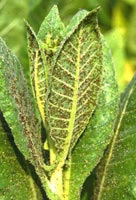 Tobacco fields treated with Admire as a transplant
water application or tray drench should still have very
good tobacco aphid control. However, aphid
numbers may building rapidly in fields that did not
receive a preventive treatment. Untreated tobacco set
May 22 in Fayette county has significant aphid
numbers, their levels are high enough to affect
expansion of bud leaves. Treatment applied now
should be targeted to protect expanding leaves at the
top of the plant. Don't expect too much control of
aphids on mid-level leaves; they will be protected
from the spray .
Tobacco fields treated with Admire as a transplant
water application or tray drench should still have very
good tobacco aphid control. However, aphid
numbers may building rapidly in fields that did not
receive a preventive treatment. Untreated tobacco set
May 22 in Fayette county has significant aphid
numbers, their levels are high enough to affect
expansion of bud leaves. Treatment applied now
should be targeted to protect expanding leaves at the
top of the plant. Don't expect too much control of
aphids on mid-level leaves; they will be protected
from the spray .
 Tobacco and tomato hornworms are getting fat.
Watch for feeding injury in the upper third of the
plant.
Tobacco and tomato hornworms are getting fat.
Watch for feeding injury in the upper third of the
plant.
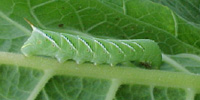
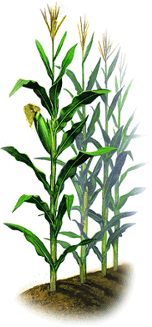
CORN
CORN INSECT UPDATE
By Ric Bessin
With the onset of July and August, producers need to
manage the midsummer pests of field corn. This
includes the corn borer, fall armyworm, and Japanese
beetle. Problems with these pests will be determined,
in part, by planting date of the fields. Generally, later
plantings have more problems with these pests.
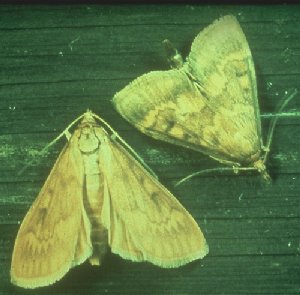 Moths from the first generation European corn borer
are now active and larvae from the second generation
will become active soon. Typically, early planted
fields have more problems with the first generation
and later plantings with the second generation. Many
producers who were in a late planting situation have
used Bt corn to avoid these late season problems.
While many producers do not have the equipment to
treat tasseled corn, heavily infested fields should be
identified for the earliest possible harvest.
Southwestern corn borer is lagging behind European
corn borer, and moth flight can be expected in the next
few weeks.
Moths from the first generation European corn borer
are now active and larvae from the second generation
will become active soon. Typically, early planted
fields have more problems with the first generation
and later plantings with the second generation. Many
producers who were in a late planting situation have
used Bt corn to avoid these late season problems.
While many producers do not have the equipment to
treat tasseled corn, heavily infested fields should be
identified for the earliest possible harvest.
Southwestern corn borer is lagging behind European
corn borer, and moth flight can be expected in the next
few weeks.
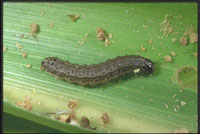 Fall armyworm can be a serious problem with corn
that is still in the whorl stage at this time. These are
the late plantings. This insect can be difficult to control
if the larvae are much larger than 1/2", so monitoring
and early control are critical. Many producers that
found themselves in a late planting situation used Bt
corn to avoid problems with late season corn borers.
However, some of the Bt corn types do not provide
any fall armyworm control, others only provide
moderate control. Late planted fields need to be
monitored for this pest, even if they are Bt corn.
Fall armyworm can be a serious problem with corn
that is still in the whorl stage at this time. These are
the late plantings. This insect can be difficult to control
if the larvae are much larger than 1/2", so monitoring
and early control are critical. Many producers that
found themselves in a late planting situation used Bt
corn to avoid problems with late season corn borers.
However, some of the Bt corn types do not provide
any fall armyworm control, others only provide
moderate control. Late planted fields need to be
monitored for this pest, even if they are Bt corn.
 Japanese beetles are causing more problems in the
western part of the state. If corn silking coincides with
peak beetle activity, silk clipping by the beetles has the
potential of interfering with pollination. However,
more commonly the silk clipping occurs after
pollination and little damage is done by the beetles.
Additionally, problems with the beetles are much
more severe on the outside rows of the field with few
beetles feeding on interior plants. Before treating for
Japanese beetles, producers need to evaluate whether
or not pollination has already occurred and if the
entire field needs to be treated or only the field margin
needs treatment.
Japanese beetles are causing more problems in the
western part of the state. If corn silking coincides with
peak beetle activity, silk clipping by the beetles has the
potential of interfering with pollination. However,
more commonly the silk clipping occurs after
pollination and little damage is done by the beetles.
Additionally, problems with the beetles are much
more severe on the outside rows of the field with few
beetles feeding on interior plants. Before treating for
Japanese beetles, producers need to evaluate whether
or not pollination has already occurred and if the
entire field needs to be treated or only the field margin
needs treatment.
For more information about corn pests, visit
"Insect Management Recommendations".

FORAGE CROPS
RESULTS FROM ADAIR COUNTY SCLEROTINIA TRIAL IN ALFALFA
By Paul Vincelli, Extension Plant Pathologist
Jimmy Henning, Extension Forage Agronomist
David Herbst, Extension Agriculture Agent, Adair County
Sclerotinia crown and stem rot of alfalfa is a
significant limiting factor for successful late-summer
seeding of alfalfa throughout the state. While alfalfa
fields are successfully fall-seeded in many instances,
dramatic outbreaks occur frequently enough that
some producers avoid fall-seeding entirely. Factors
that increase risk of this disease include: known
history of the disease; no-till seeding; and late seeding
(particularly after Labor Day).
This disease has been a frustrating one to work on.
Essentially everything we at UK have tested in our
research program has failed to provide any increment
of disease control, except the use of experimental,
unlabeled fungicides. Thus, any research data
showing some promise for giving even partial control
of this disease gets our attention. Any incremental
improvement against this disease would be welcome.
After all, such practices as early seeding do just
that give plants more time to develop some degree of
partial resistance.
Several currently available alfalfa varieties
Interceptor, DK141, Cimarron VR, WL 332 SR -- are
reported to have partial resistance to Sclerotinia crown
and stem rot (SCSR). Let us stress the term PARTIAL
resistance. No claims are made that these varieties
will prevent the disease, nor that they will hold up
under severe disease pressure. However, as stated
above, we are interested in any possible increase in
resistance against this difficult-to-control disease.
Varieties with partial resistance have performed well
in tests in certain other states but typically have
performed very poorly in UK tests. Our interpretation
of the research is that disease pressure is particularly
high in Kentucky.
Adair County Test
In 1996, an experiment was initiated under
commercial conditions in Adair County to evaluate
three varieties: Cimarron VR and WL 332 (both
reported to have partial resistance to SCSR) and
Fortress (a susceptible but otherwise high-yielding
variety). The field was in no-till corn in 1995 and a red
clover/orchardgrass pasture prior to that. Roundup
at 1 qt/A was applied as a burndown. Replicated
plots were seeded no-till on 23 Sep 96 at 18 lb seed/A;
plots were separated by orchardgrass strips. A
uniform, vigorous stand was established in autumn,
1996.
On 6 May 97, with about 8-10" of height on surviving
alfalfa, percent ground cover was estimated visually
at various locations in each plot. The presence of
sclerotia on dead plants confirmed the cause of the
stand loss. The plots were revisited twice in April,
2000, and additional data on stand health were
collected.
Results
Weather was favorable for Sclerotinia activity for
much of the autumn and winter following seeding.
Based on stand survival, disease pressure was
moderately severe to severe throughout the field,
resulting in very poor ground cover in all three
varieties (Table 1). Varieties tested did not differ
significantly in % ground cover during the first spring
following a moderately severe outbreak of SCSR.
Variability in response was extreme, probably a
reflection of variation in disease pressure in the field.
Since that initial assessment, substantial recovery and
plant compensation occurred in the plots, and
acceptable stands developed in some plots. Cimarron
VR, a variety marketed as having moderate resistance
to SCSR, provided a modest but statistically
significant improvement in ground cover over
Fortress, the susceptible check, in April 2000. This is
the first time we have seen statistically significant
improvement in plant health from SCSR-resistant
varieties in a UK research trial. Note that, even in
Cimarron VR, there was still incomplete alfalfa
ground cover three years after the initial outbreak.
Clearly the disease can have long-lasting impacts even
in varieties with partial resistance.
WL 332 SR, a variety marketed as being Sclerotinia-
resistant, showed no significant improvement in
ground cover over the susceptible check. We have
tested this variety twice with similar results. WL332
SR undoubtedly has some genes for resistance to
SCSR, since it has performed well in tests further
north, but evidently its resistance is not sufficient
under Kentucky conditions.
Table 1. Adair County Sclerotinia Test on Alfalfa.
| |
% ground cover
6 May 97 |
% ground cover |
| Cultivar |
Mean (1) |
Range |
12 Apr 00 |
28 Apr 00 |
| Cimarron VR |
22 a (2) |
2-65 |
63 a |
79 a |
| 13 a |
1-30 |
46 b |
68 b |
|
| Fortress |
7 a |
1-20 |
41 b |
62 b |
(1) ANOVA effect for cultivar is insignificant (P>0.2)
(2) Means followed by the same letter are not significantly different, Waller-Duncan k-ratio t-test, k=100, P=0.05
Our results from Adair County and previously published
studies suggest the following.
- Certain alfalfa varieties with partial resistance to SCSR
may provide for a modest but statistically significant
improvement in stand health for fall seedings, should SCSR
become active at the site.
- Don't expect complete control of SCSR from alfalfa
varieties with partial resistance.
- Some varieties reported to have partial resistance to
SCSR may not exhibit any resistance under Kentucky
conditions.
- Alfalfa has the ability to compensate for stands thinned
by SCSR increasing the size of individual plants.
Bottom line: Producers considering seeding alfalfa
late this summer should first consider the field's
relative risks for a SCSR outbreak; see the UK
Extension publication Risk Factors for Sclerotinia Crown
and Stem Rot of Fall-Seeded Alfalfa, PPFS-AG-F-2, for
more information. If planning to fall-seed alfalfa,
there may be some value in selecting a variety that has
been shown to have partial resistance to SCSR, in
addition to other desirable traits like multipest
resistance, high yields, and persistence, especially if
this has been demonstrated under Kentucky
conditions.
Thanks are expressed to Mr. Randy Nelson in Adair
County, who was willing to conduct this test on his
farm.

SOYBEANS
SOYBEAN CYST NEMATODE INFESTATIONS OFTEN HIDDEN
By Don Hershman
Most grain producers are well aware of the concept
that disease organisms induce diseases in plants, and
that each disease is associated with the expression of
one or more symptoms. In fact, it is almost always the
symptoms which alert the producer that all is not
"right" in any given crop. In soybeans, most disease
organisms produce more or less distinctive symptoms
that make field diagnosis rather easy. This is
especially true for diseases cause by fungi. In contrast,
symptoms resulting from infection by viruses are the
least distinctive and definitive field identification is
usually not possible.
As familiar as producers are with the disease -
symptom connection, the concept that a disease
organism may severely damage a plant, without
visible symptoms being produced, is foreign to most
of them. Admittedly, this situation is rather rare. Most
of the time when a crop is going to have significantly
reduced yields, you will know it by the poor overall
appearance of the crop. However, this is not usually
the case when Soybean Cyst Nematode (SCN) is
involved. The bottom line is that although SCN
infections can produce specific and severe symptoms,
most of the time, especially in a vigorously-growing
crop, symptom expression is minimal, even when
yields are reduced by 30 or more percent. This is a
fairly unique situation, as far as diseases are
concerned, and it is one reason why producers are
often unaware of the fact that their crops are being
severely damaged by SCN.
"How can the above situation occur ?" is a question I
often hear. Here is the explanation: SCN male and
female juveniles penetrate plant roots and, after
mating, the males leave the root and females migrate
to feeding sites within the root. The penetration and
movement of SCN juveniles into and within roots,
respectively, as well as feeding activities and
development of female cyst nematodes disrupt water
and nutrient uptake by the plant. This disruption
affects the growth and development of plants, both
above ground and below ground. But as long as
nutrient and water supplies are not limiting, plants
will respond primarily by producing fewer seed.
Basically, the biochemical and physiological process
that relate to and result in crop yield determination
are affected. If you had a side-by-side comparison
available with a healthy crop you and a time-lapsed
movie, you would see how this happens. Affected
plants will grow slower, canopy closure will be
delayed (resulting in weed competition and increased
soil water loss), plant root and shoot systems will be
reduced (i.e., stunted), net food productivity by plant
foliage will be reduced, flower numbers will be
reduced and pod abortion will be increased compared
to healthy plants. All of these "symptoms" result in
lower crop yields, but few of these symptoms would
be detected during a casual or even comprehensive
field examination.
The main point is to not assume that your soybean
fields are as productive as they can be just because the
plants look healthy. Unless you know for a fact that a
field is not infested by SCN, we recommend you begin
to test for SCN on your farm. For a variety of different
reasons, the fall is a good time to sample fields and
assess where you stand in regards to farm-wide SCN
infestation. Place a priority on fields that will be in
soybean next season. If you decide to take samples
from poor looking or poor yielding soybean crops this
season, be advised that those efforts will only confirm
the presence or absence of SCN in a field. However, a
sample taken in the fall will allow you to develop an
effective, comprehensive, and long term SCN
management program. For more information about
sampling fields for SCN analysis, contact your local
county Extension office.
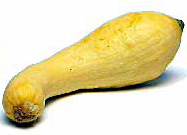
VEGETABLES
NOVA LABELED ON CUCURBITS FOR POWDERY MILDEW CONTROL
By William Nesmith
The DMI fungicide Nova 40W (myclobutanil)
marketed by Rohm & Haas has been labeled
nationally for cucurbits. The rate is 2.5 to 5 oz/A.
Applications should begin at first signs of disease
development and continue on a 7 to 10 day schedule.
Application can be made up to, and including the day
of harvest. Other fungicides will be needed to control
the other diseases of cucurbits.
Unfortunately, this new fungicide has a high risk for
resistance development, as do all the other new and
highly effective mildewcides. Thus, it is imperative to
use them in a fungicide program designed to manage
resistance. I will have more to say about this in later
articles, but see
ID-36 Vegetable Production Guide
for general information and other fungicides labeled for
cucurbit crops.

LAWN & TURF
MIDSUMMER CULTIVATION TO REDUCE SPRING DEAD SPOT OF BERMUDAGRASS
By Paul Vincelli
Spring dead spot is the most serious disease of
bermudagrass in Kentucky. Current management
recommendations for the disease include acidification
of the soil through use of ammonium-based fertilizers
or sulfur and, in late summer, increasing mowing
height and reducing nitrogen applications. Although
these practices can help reduce the disease, it may still
develop to notable levels in "hot spots" in
bermudagrass swards.
Research by Drs. N. Tisserat and J. Fry at Kansas State
University has shown that midsummer cultivation to
disturb the upper root zone can lessen spring dead
spot pressure. Of course, the long period for turf
recovery negates the value of this treatment for most
turf uses. However, they showed that the more
agronomically acceptable treatment of aerification
plus verticutting provided for significant reductions in
disease severity over an untreated control. The use of
either treatment by itself did not provide consistent
reductions in the disease. Based on their studies, turf
professionals who manage bermudagrass in Kentucky
should consider instituting a program of aerification
and verticutting twice once in early July and again in
early August (assuming adequate soil moisture to
promote recovery)--in those turf areas where the
disease has been particularly active. The only
exception to this recommendation is for football fields,
where UK agronomists recommend aerification as
often as possible but avoiding verticutting, which may
greatly enhance the potential of the sod to "kick out"
during games.
WHAT WAS THAT BIG YELLOW, ORANGE & BLACK THING?!?
By Mike Potter
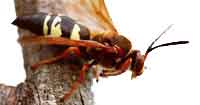 Cicada killers are now flying, prompting several calls
from homeowners. Despite their menacing
appearance (up to 2 inches long with rusty red
head/thorax, amber-yellow wings, and black and
yellow striped abdomen), the wasps seldom sting
unless handled or otherwise molested.
Cicada killers are now flying, prompting several calls
from homeowners. Despite their menacing
appearance (up to 2 inches long with rusty red
head/thorax, amber-yellow wings, and black and
yellow striped abdomen), the wasps seldom sting
unless handled or otherwise molested.
Cicada killers do not live in communal nests like
hornets or yellowjackets. They overwinter as larvae
within cocoons, deep in the soil, emerging as adults
during July. The females feed, mate, and excavate
burrows in the ground about ½ inch in diameter,
ending in a series of brood chambers. Excess soil is
pushed out of the burrow, leaving a small, U-shaped
mound of dirt at the entrance. Each female excavates
numerous burrows and provisions them with adult
cicadas which she ambushes, paralyzes with her
venom, and stuffs into individual brood chambers.
She then lays an egg on top, backs out, and seals the
cell behind her. The egg hatches within a few days
and the hungry larva devours the offering, eventually
transforming into a pupa the following spring.
Management - Cicada killers seldom sting and the
females normally do not defend their burrows. The
males, while incapable of stinging, sometimes dive-
bomb passers-by, or hover menacingly nearby.
Insecticide treatment may be warranted where the soil
burrows become unsightly. Individual burrows can be
effectively dusted or sprayed with most yard
insecticides (e.g., Sevin, diazinon, Bayer Advanced
Lawn & Garden Multi-Insect Killer) or a wasp &
hornet aerosol spray. Large numbers of nests may
need to be treated with a broadcast application to the
surface of the turf.
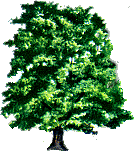
SHADE TREES AND ORNAMENTALS
LEAF SPOTS CAN DAMAGE ENGLISH IVY
By John Hartman
There are two important English Ivy (Hedera) leaf spot
diseases in Kentucky, one caused by a bacterium, and
one by a fungus. The two diseases are sometimes
difficult to distinguish. The warm weather and
periodic thundershowers of recent weeks have
favored ivy leaf spot diseases.
Bacterial leaf spot is favored by periods of warm, wet
weather typical of summer in Kentucky. Bacteria
living on the leaf surface may be splashed from plant
to plant and driven into the leaf through open stomata
during daytime thundershowers. This disease, caused
by the bacterium Xanthomonas campestris pv. hederae, is
especially damaging now to ivy growing in many
landscapes. The bacteria invade leaves, shoots, and
stems through stomata and wounds causing, on the
leaves, a greenish-brown angular spot 1/4 to 1/2 inch
or larger in size. The spots sometimes appear greasy
and may have a yellow margin; as they age, spots turn
dark brown and may crack as they dry.
The disease is diagnosed in the laboratory by
observing bacterial streaming under the microscope.
However, the disease is so active now that county
agents or landscape industry specialists can also
diagnose the disease in the field in the same way. Cut
through several leaf spots with a sharp knife and
place small infected leaf pieces on a glass slide. Add a
drop or two of clean water to the infected tissue and
cover with a small glass cover slip. After a few
minutes to an hour, bacterial streaming can be seen
just by holding the glass slide up to the light and
observing the milky color of the water near the
dissected leaf spot.
Growers should avoid planting diseased plant
material, and avoid sprinkler irrigation which
splashes bacteria from diseased to healthy plants.
Copper-based fungicides which also serve as
bactericides can be used to slow the spread of bacterial
leaf spot.
Fungal leaf spot (anthracnose) appears as large,
irregularly shaped tan or brown spots having
numerous pimple-like fungal fruiting structures in the
dead tissues. The causal fungus is Glomerella cingulata,
however, the imperfect fungal state, Colletotrichum, is
normally observed now. Close examination with a
hand lens may show spine-like formations associated
with the fungal fruiting structures. There are other
fungal leaf spot diseases of English Ivy which also
produce fungal fruiting structures; these distinguish
them from bacterial spot, which produces none.
Fungal spots do not produce bacterial streaming as
described above. Spores of the fungi causing leaf
spots may be splashed from plant to plant by rainfall.
Controls for anthracnose and fungal leaf spots are
similar to controls for bacterial leaf spot, except that
fungicides such as thiophanate-methyl [Cleary's 3336]
(cleared for anthracnose of landscape plants) and
mancozeb [Fore] (used for fungal leaf spots of
ornamentals and which can be tried on unlabeled
ornamental plants) are also available.

DIAGNOSTIC LAB HIGHLIGHTS
DIAGNOSTIC LAB - HIGHLIGHTS
By Julie Beale and Paul Bachi
Samples seen in the Diagnostic Lab last week
included: maize dwarf mosaic virus and maize
chlorotic dwarf virus on corn; angular leaf spot, target
spot, blue mold, tobacco streak virus, tomato spotted
wilt virus, Fusarium wilt, root knot nematode, black
root rot, black shank and soreshin on tobacco.
On fruits and vegetables, we have seen scab,
cedar-apple rust, and frogeye on apple; Blumeriella
leaf spot on plum; black rot and anthracnose on grape;
tomato ringspot virus on blackberry; bacterial leaf
spot on oregano; bacterial spot on pepper; bacterial
spot and tomato spotted wilt virus on tomato; and
rust on sweet corn.
On ornamentals, we have seen brown patch on fescue
and ryegrass; Bipolaris leaf blight on bermudagrass;
Rhizoctonia stem and root rot on petunia and lily;
southern stem blight and canker (Colletotrichum) on
phlox; bacterial spot on barberry; hypoxylon canker
on oak; and Botryosphaeria canker and dieback on
willow.

IPM TRAP COUNTS:
By Patty Lucas, University of Kentucky Research Center
Insect Trap Counts
|
| UKREC-Princeton, KY, Jun 30 - July 7, 2000
|
| Fall Armyworm
| 2
|
| True Armyworm
| 4
|
| Corn Earworm
| 13
|
| European Corn Borer
| 10
|
| Southwestern Corn Borer
| 90
|
ANNOUNCEMENTS
TURF FIELD DAY SET FOR JULY 13
By Paul Vincelli
The UK Turf Field Day is set for Thursday, July 13, at
the UK Turf Center. The Turf Center is located on the
UK Research Farm off Ironworks Pike, a mile or two
east of the Kentucky Horse Park. Tours begin at 9:00
am and will end around noon. A great variety of
research trials and demonstrations can be seen at the
field day, and it is an excellent chance to discuss the
latest in turfgrass science in an informal setting.
Come one, come all, and be welcome!
FALL 2000 COMMERCIAL PESTICIDE APPLICATOR TRAINING
By Lee Townsend
Dates and locations have been set for this fall's
commercial pesticide applicator training sessions for
Categories 1: Agricultural Plant, 2a: Forest Pest
Control, 3: Ornamental & Turf, 4: Seed Treatment, 10:
Demonstration & Research, and 12: Pesticide Dealer.
Agendas will be developed later.
September 20 (Wednesday), 2000: Fayette County
Cooperative Extension Office, Lexington
October 12 (Thursday), 2000: University of
Kentucky Research & Education Center, Princeton

2000 INSECT MANAGEMENT RECOMMENDATIONS
FOR FIELD CROPS AND LIVESTOCK
By Lee Townsend
The 2000 Field Crops and Livestock Insecticide Recommendations are available on-line.
You can select crop or livestock pests from appropriate menus. You will get graphics, scouting
information, decision guides, and recommended pesticides. There are links to publications and fact
sheets. Newly registered products will be placed here as appropriate.
Click here to view: 2000
Field Crops and Livestock Insecticide Recommendations
Bookmark the page for future reference.
Lee Townsend
Extension Entomologist
BACK
TO KY PEST NEWS HOME
 Blue Mold Warning for the following Kentucky Extension Areas: Bluegrass, Ft. Harrod, Licking River, and Northeast Kentucky. A warning means the disease is active and expected conditions should favor continued and increasing activity in the warning area.
Blue Mold Warning for the following Kentucky Extension Areas: Bluegrass, Ft. Harrod, Licking River, and Northeast Kentucky. A warning means the disease is active and expected conditions should favor continued and increasing activity in the warning area.
 Fields: Foliar fungicide sprays made at this time can greatly reduce the potential for blue mold building up in the field. While the level of activity is low and the leaves in the lower portions of the plant can be easily reached, fungicide applications with Acrobat MZ will eliminate blue mold. The systemic aspect of this fungicide makes it especially valuable in blue mold control early in the epidemic. Preventive field applications of fungicides are especially needed at this time for sites set with highly susceptible varieties in foggy sites, especially those in rotated land (due to superior growth potential) and creek or river bottoms. Use Acrobat MZ at 2.5 lbs /100 gallons of water, adjusting the concentration and volume of fungicide to the stage of growth, according to the label. Repeat the applications at weekly intervals. Timely topping and sucker control should be practiced to aid in blue mold control.
Fields: Foliar fungicide sprays made at this time can greatly reduce the potential for blue mold building up in the field. While the level of activity is low and the leaves in the lower portions of the plant can be easily reached, fungicide applications with Acrobat MZ will eliminate blue mold. The systemic aspect of this fungicide makes it especially valuable in blue mold control early in the epidemic. Preventive field applications of fungicides are especially needed at this time for sites set with highly susceptible varieties in foggy sites, especially those in rotated land (due to superior growth potential) and creek or river bottoms. Use Acrobat MZ at 2.5 lbs /100 gallons of water, adjusting the concentration and volume of fungicide to the stage of growth, according to the label. Repeat the applications at weekly intervals. Timely topping and sucker control should be practiced to aid in blue mold control.
 Few fungicides and bactericides are labeled for foliar
use in tobacco fields in Kentucky. The following
options are available for the 2000 season:
Few fungicides and bactericides are labeled for foliar
use in tobacco fields in Kentucky. The following
options are available for the 2000 season:
 Tobacco fields treated with Admire as a transplant
water application or tray drench should still have very
good tobacco aphid control. However, aphid
numbers may building rapidly in fields that did not
receive a preventive treatment. Untreated tobacco set
May 22 in Fayette county has significant aphid
numbers, their levels are high enough to affect
expansion of bud leaves. Treatment applied now
should be targeted to protect expanding leaves at the
top of the plant. Don't expect too much control of
aphids on mid-level leaves; they will be protected
from the spray .
Tobacco fields treated with Admire as a transplant
water application or tray drench should still have very
good tobacco aphid control. However, aphid
numbers may building rapidly in fields that did not
receive a preventive treatment. Untreated tobacco set
May 22 in Fayette county has significant aphid
numbers, their levels are high enough to affect
expansion of bud leaves. Treatment applied now
should be targeted to protect expanding leaves at the
top of the plant. Don't expect too much control of
aphids on mid-level leaves; they will be protected
from the spray .
 Tobacco and tomato hornworms are getting fat.
Watch for feeding injury in the upper third of the
plant.
Tobacco and tomato hornworms are getting fat.
Watch for feeding injury in the upper third of the
plant.


 Moths from the first generation European corn borer
are now active and larvae from the second generation
will become active soon. Typically, early planted
fields have more problems with the first generation
and later plantings with the second generation. Many
producers who were in a late planting situation have
used Bt corn to avoid these late season problems.
While many producers do not have the equipment to
treat tasseled corn, heavily infested fields should be
identified for the earliest possible harvest.
Southwestern corn borer is lagging behind European
corn borer, and moth flight can be expected in the next
few weeks.
Moths from the first generation European corn borer
are now active and larvae from the second generation
will become active soon. Typically, early planted
fields have more problems with the first generation
and later plantings with the second generation. Many
producers who were in a late planting situation have
used Bt corn to avoid these late season problems.
While many producers do not have the equipment to
treat tasseled corn, heavily infested fields should be
identified for the earliest possible harvest.
Southwestern corn borer is lagging behind European
corn borer, and moth flight can be expected in the next
few weeks.
 Fall armyworm can be a serious problem with corn
that is still in the whorl stage at this time. These are
the late plantings. This insect can be difficult to control
if the larvae are much larger than 1/2", so monitoring
and early control are critical. Many producers that
found themselves in a late planting situation used Bt
corn to avoid problems with late season corn borers.
However, some of the Bt corn types do not provide
any fall armyworm control, others only provide
moderate control. Late planted fields need to be
monitored for this pest, even if they are Bt corn.
Fall armyworm can be a serious problem with corn
that is still in the whorl stage at this time. These are
the late plantings. This insect can be difficult to control
if the larvae are much larger than 1/2", so monitoring
and early control are critical. Many producers that
found themselves in a late planting situation used Bt
corn to avoid problems with late season corn borers.
However, some of the Bt corn types do not provide
any fall armyworm control, others only provide
moderate control. Late planted fields need to be
monitored for this pest, even if they are Bt corn.
 Japanese beetles are causing more problems in the
western part of the state. If corn silking coincides with
peak beetle activity, silk clipping by the beetles has the
potential of interfering with pollination. However,
more commonly the silk clipping occurs after
pollination and little damage is done by the beetles.
Additionally, problems with the beetles are much
more severe on the outside rows of the field with few
beetles feeding on interior plants. Before treating for
Japanese beetles, producers need to evaluate whether
or not pollination has already occurred and if the
entire field needs to be treated or only the field margin
needs treatment.
Japanese beetles are causing more problems in the
western part of the state. If corn silking coincides with
peak beetle activity, silk clipping by the beetles has the
potential of interfering with pollination. However,
more commonly the silk clipping occurs after
pollination and little damage is done by the beetles.
Additionally, problems with the beetles are much
more severe on the outside rows of the field with few
beetles feeding on interior plants. Before treating for
Japanese beetles, producers need to evaluate whether
or not pollination has already occurred and if the
entire field needs to be treated or only the field margin
needs treatment.



 Cicada killers are now flying, prompting several calls
from homeowners. Despite their menacing
appearance (up to 2 inches long with rusty red
head/thorax, amber-yellow wings, and black and
yellow striped abdomen), the wasps seldom sting
unless handled or otherwise molested.
Cicada killers are now flying, prompting several calls
from homeowners. Despite their menacing
appearance (up to 2 inches long with rusty red
head/thorax, amber-yellow wings, and black and
yellow striped abdomen), the wasps seldom sting
unless handled or otherwise molested.



